Table of Contents
Table of Contents
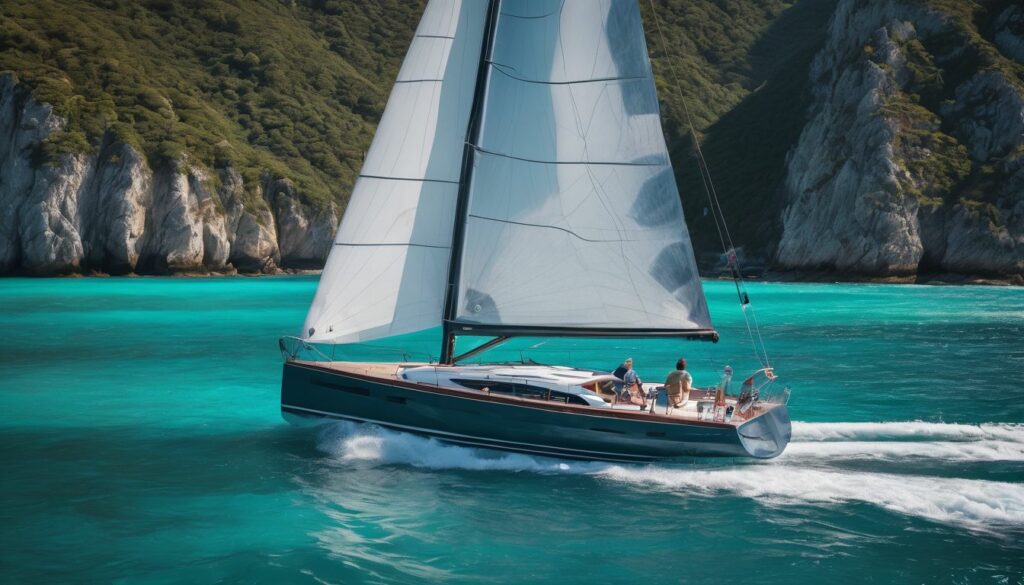
Navigating the vast array of sailboat options can seem daunting, especially when it comes to understanding hull types. A vital fact is that the hull type significantly influences a sailboat’s performance and comfortability at sea.
This blog will demystify different types of sailboat hulls, discussing from monohulls to trimarans, and examine how each impacts speed, stability, and space! Ready for some nautical knowledge? Dive in!
Key Takeaways
- Sailboats can have different hulls like monohulls, catamarans, and trimarans. Each hull type affects the boat’s speed, stability, and space.
- The shape of a sailboat’s hull greatly impacts its performance. Flat-bottom boats go fast while bilge keel cruisers are stable in rough seas.
- Sailboat hull shapes include flat-bottom, bulb keel, fin keel, bilge keel, semi-displacement, and displacement hulls. Each shape offers unique advantages for sailing.
- Different hull types suit different needs: planing hulls offer top speeds; displacement sailboats promise comfort in motion; multi-hull boats provide the most space.
Understanding the Importance of Sailboat Hull Design
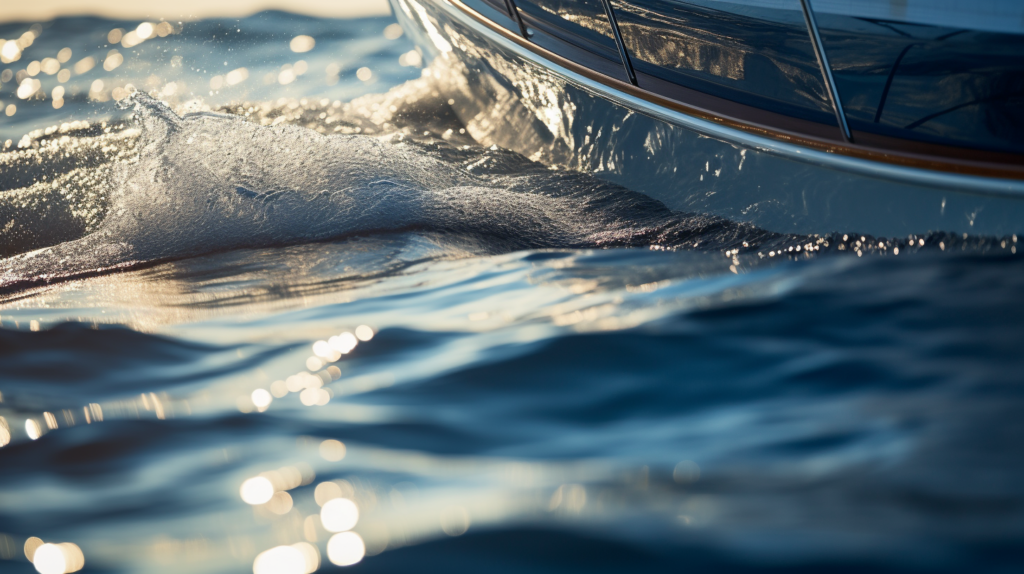
The design of a sailboat hull has a significant impact on the vessel’s overall performance. Ensuring an optimum balance between speed, stability, and smooth sailing requires careful consideration of hull shapes and features.
Flat-bottomed vessels and fin-keel racers tend to prioritize speed while bilge keel cruisers focus more on stability in rough seas.
Sailboats with heavy semi-displacement or full-displacement designs bring forth superior endurance for long ocean voyages. On the other hand, catamarans and trimarans belong to multihull designs which offer increased comfort due to wide beams offering ample space onboard.
The shape of these hulls significantly influences their capabilities – for example, round-bottomed hulls allow graceful movements through water whereas v-shaped ones cut through waves.
Hull designs also incorporate mechanisms like centerboards and swing keels which enhance windward performance by reducing sideways drift when sailing close-hauled or tacking upwind.
Every mast step position, ballast placement, o and foil shape contribute toward defining a sailboat’s character as much as its skipper does! Therefore it’s paramount that sailors understand their boat’s anatomy beneath its waterline since it can dramatically affect handling characteristics under different conditions at sea.
The Different Types of Sailboat Hulls
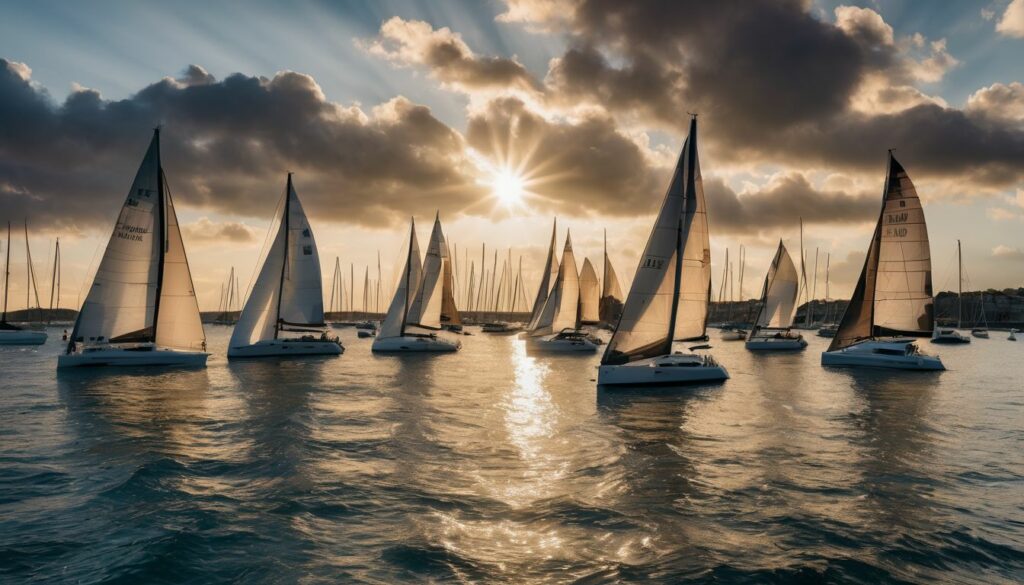
Explore the variety of sailboat hulls we typically see in today’s sailing world. We delve into three main types: monohulls, catamarans, and trimarans – each boasting its unique features and design principles.
Whether it’s a single-hulled monohull or boats with multiple hulls like the catamaran (two hulls) and trimaran (three hulls), understanding their attributes is fundamental to your sailing experience.
Learn about their distinctive characteristics, advantages, and why sailors might choose one over another.
Monohull
Monohulls stand as the most familiar type of sailboat hull. Single-hulled and streamlined, they slice through the water gracefully with an easy-to-manage design that makes them a common choice among sailors.
Monohull sailboats often possess displacement hulls and require a keel for stability – key features in their construction.
While these boats might lack the initial stability of their multi-hulled counterparts, they make up for it in resilience. A monohull can recover quickly from a roll or capsize, ensuring safety during unexpected shifts.
They come in various designs such as flat-bottom vessels for smooth waters, fin-keel racers for competitive sailing, but,b, and bilge keel cruisers for comfortable journeys, semi-displacement sailboats for heavy loads, and full-keel displacement cruisers appropriate even in deep seas.
Catamaran
Catamarans boast two hulls, setting them apart from the more common single-hull monohulls. The double-hull design enhances stability and allows catamarans to reach higher speeds. Their wide beam creates spacious cabins, making them an ideal pick for sailors desiring comfort without compromising on speed or stability.
Despite being less common than traditional monohulls, they are gaining popularity in various sailing communities for their unique advantages. Unlike other sailboat types, catamarans exhibit a different hull type which significantly contributes to their noteworthy performance on water.
Trimaran
Sailors often favor Trimarans for their three hulls – a feature that lends them remarkable stability. This third central hull also provides more living space, making long voyages comfortable and enjoyable.
The streamlined design of these sailboats allows them to reach impressive speeds on water, significantly outpacing many other types of boats. Perhaps the most unique element is their “unsinkable” quality: even if both side hulls fill with water, a Trimaran remains afloat due to its buoyant center hull.
Deeper Look into Sailboat Hull Shapes
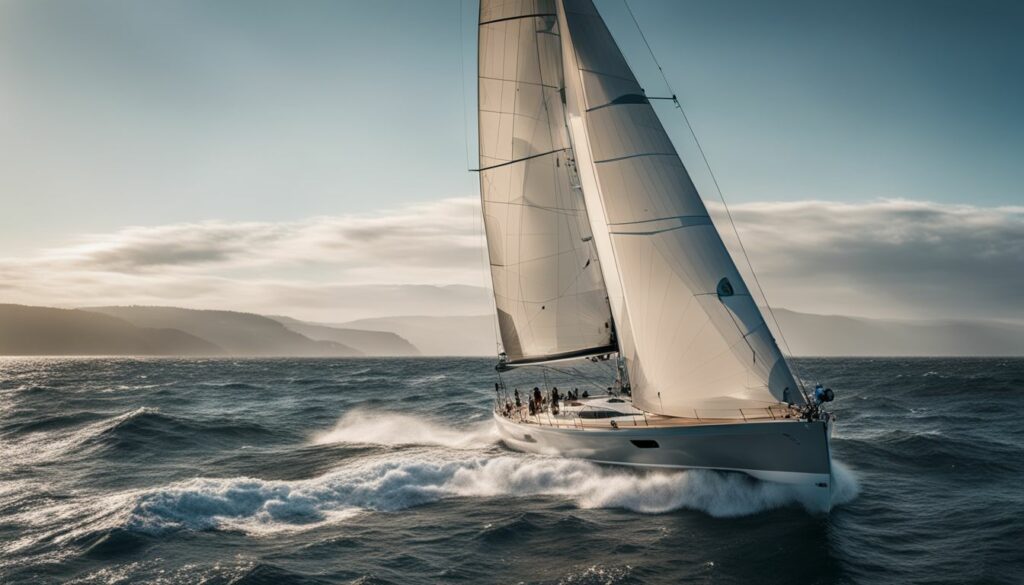
Discover the art and science behind various sailboat hull shapes, including flat-bottom, fin keel, bulb keel, bilge keel, semi-displacement, and nd displacement hulls. Unveiling their unique designs will help you grasp how each impacts a boat’s performance.
Intriguing right? Stay with us as we delve into these fascinating details for an enlightening journey at sea!
Flat-Bottom Sailboats
Flat-bottom sailboats are synonymous with speed and adaptability. With their simplistic design, these boats boast a lightweight structure that enhances performance while maintaining stability.
Their broad, flat base allows for easy maneuvering across the water while creating minimal wave disturbance – an ideal choice for both racing and casual sailing. The high-speed potential of a flat-bottomed sailboat is due in part to its ability to rise at higher velocities, effectively reducing drag in the water.
Despite their impressive speed capabilities, they offer ample space – an attractive feature for camping adventures or extended day trips on the water.
Fin Keel Sailboat Hulls
Fin keel sailboat hulls are commonly found in monohull sailboats. The design offers ample space, both above and below the deck, making it a popular choice for many sailors. These hulls are not just about providing room – they also enhance the boat’s performance on water.
High cruising speeds demand reduced drag – exactly what fin keel sailboat hulls deliver. This type of hull allows for improved maneuverability, ensuring an easier and smoother sailing experience.
Whether you’re racing or simply enjoying a cruise, this design provides enhanced handling capabilities that improve your journey on the water.
Bulb Keel Sailboat Hulls
Bulb keel sailboat hulls possess a distinctive element, a bulb-like extension at the base of the keel. This unique feature aims to lower the boat’s center of gravity, thereby significantly enhancing its stability on water.
Often spotted adorning racing sailboats, these designs are chosen for their remarkable contribution towards superior performance.
The bulbous extension in this type of hull aids in counterbalancing the force exerted by the sail and helps to diminish heeling. A deeper draft is another characteristic advantage that can notably boost upwind performance due to improved underwater profile and reduced drag.
With bulb keel designs, you’re guaranteed excellent control and a fast saving experience without compromising safety or comfort.
Bilge Keel Sailboat Hulls
Bilge keel sailboat hulls are a distinctive type of boat design. These boats feature two keels offset on the port and starboard side. The dual-keel configuration leads to enhanced stability when moored or sailing in shallow waters.
Bilge keel sailboats fare well during low tides, as they can rest upright without leaning onto their sides as single-keeled boats do. Sailors often choose bilge keel designs for their impressive motion comfort and precise tracking ability, making these sailboats an excellent choice for extended cruising adventures.
Despite being slower than some other types of hulls due to increased drag, the benefits of stability and versatility make them desirable among many boaters.
Semi-Displacement Sailboat Hulls
Semi-displacement sailboat hulls strike a perfect balance between cruising comfort and performance. They inherit attributes from both planing and displacement hull types, creating a versatile sailing experience.
Unlike slower displacement hulls, semi-displacement models can achieve higher speeds due to their ability to get on a plane quickly. Their design incorporates stability with efficiency, making them an excellent choice for sailors who prefer the best of both worlds in their maritime adventures.
Sailboats equipped with semi-displacement hulls provide not only swift sailing but also enhanced handling in various water conditions.
Displacement Sailboat Hulls
Displacement hulls represent a main type of sailboat design, familiar to many sailors. These hulls operate by moving water aside, smoothly cutting through it as the boat propels forward.
With this particular design, less power is required for motion over the water than you’d see with planing hulls.
The speed of a sailboat with a displacement hull is determined by its waterline length – longer lengths generally equate to higher potential speeds. This fundamental principle is what makes them an excellent choice for larger boats such as fishing vessels, freighters, and cruise ships.
Sailing enthusiasts will often spot these on monohull sailboats, given that they’re the most common style where displacement designs thrive.
Hull Types and Their Impact on Performance
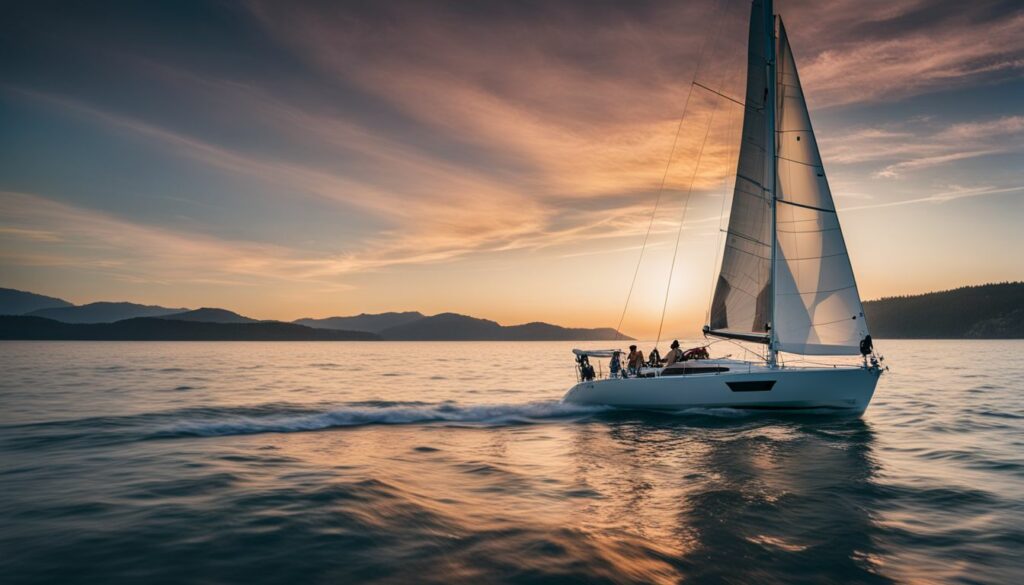
This section will dive deep into how different hull types affect sailboat performance, including speed and comfort. We’ll explore which hull shape is best for top speeds, where time on the ocean matters most, and which offers a smoother ride in choppy waters for luxury cruising.
Additionally, we’ll discuss which type of hull provides more room below the deck for storage or living space. Together we’ll unravel the link between design and functionality when it comes to sailboat’s hulls.
Best Sailboat Hull Shape for Speed
For optimal speed, the planing hull is a top contender. This type of sailboat hull is specifically designed to lift out of the water and skim across the surface at high speed. The lightweight build increases buoyancy while its shallow draft reduces drag significantly, making it ideal for racing.
Boats like dinghies or performance-oriented monohulls often employ this design due to its remarkable speed capabilities when combined with adequate wind power. However, it’s crucial to note that proficient sailing skills are needed as these can be difficult boats to handle in heavy weather conditions due to their stability trade-off for increased speed abilities.
Best Sailboat Hull Shape for Motion Comfort
Monohull sailboats take the lead in offering excellent motion comfort. They flaunt a design that naturally leans into the wind, which helps to stabilize the boat even during tumultuous conditions.
Notably, these ships gain more stability as winds speed up, resulting in smoother and more comfortable rides for sailors.
However, if you’re looking for a hull shape that’s purposefully built for both stability and comfort, then displacement sailboats are your best bet. With their full keel hulls designed solely for offshore sailing, they outperform most other types when it comes to maintaining balance in rough sea conditions.
Semi-displacement sailboats also offer desirable characteristics with their enhanced stability features gearing them towards offshore cruising and improved motion comfort. Lastly, bilge keel sailboats are known for superior tracking capabilities and increased stability thus promising high levels of motion comfort onboard.
Most Spacious Sailboat Hull Type
The multi-hull sailboat steals the spotlight as the most spacious of hull types. Boasting a design with two or three hulls, catamarans, and trimarans offer a substantial volume below deck and generous space above, making them ideal for long trips or large groups.
These types of boats have living quarters that provide comfort similar to home, thanks to their increased stability and maneuverability compared to monohulls. In addition, pontoon boats are recognized for their ample deck space owing to their design that rides on aluminum tubes.
Although displacement hulls on sailboats may give more room below deck, they don’t quite match up in terms of overall accessible space provided by multi-hull designs.
How to Inspect a Sailboat Hull
Paying close attention to your sailboat’s hull is vital for maintaining optimal performance and safety. Here are a few steps to guide you through the inspection process:
- Start by examining the exterior of the hull for visible damages such as cracks, blisters, or signs of impact.
- Check the condition of the paint and varnish on the hull. Peeling or flaking could indicate an issue.
- Look at the waterline for any discoloration which might be a sign of corrosion.
- Inspect the keel of your sailboat, whether it is a single-hull monohull or a multi-hull design like catamarans and trimarans.
- For monohulls, pay attention to the flat-bottom vessels, fin-keel racers, and bulb, and bilge keel cruisers among others.
- On multihulls – catamarans and trimarans – focus on each separate hull for uniformity in shape and condition.
- Use your hands to feel along the surface of the hull for any uneven areas that might not catch your eye but could affect performance.
- Get underneath your boat and check out the bottom of the hull; look out for algae growth or barnacles which can slow down your boat considerably.
- Finally, always examine your sailboat’s hull both before and after sailing for any new damage that may have occurred during your voyage.
Conclusion
Sailboat hulls can be as diverse as the boats themselves, each with distinct advantages. From monohulls to multihulls, flat-bottomed to bulb keel designs, these varieties of hulls shape a sailboat’s performance and usage.
For every sailor out there, understanding their boat’s hull type is an integral part of their navigation journey. Happy sailing!
Related Articles
What are the parts of a sailboat? An Illustrated Guide to Different Parts of a Sailboat and Sails
FAQs
1. What are the different types of hulls that sailboats have?
Sailboats can have a variety of hull types, including displacement hulls, planing hulls, semi-displacement hulls, and many other types.
2. Can a sailboat have more than one hull?
Yes, catamarans have two hulls, which are parallel to each other. Catamarans offer great stability and spaciousness, making them popular for sailing and cruising.
3. How does a boat’s shape change with the type of its hull?
The shape of their hull changes depending on whether it’s flat-bottomed or V-shaped for example; this affects how fast or stable the boat is in varying water conditions.
4. What is a displacement sailboat?
A displacement sailboat features a specific kind of design in which the boat’s weight acts to displace an equal volume of water, hence allowing it to float smoothly even at slower speeds.
5. Are there boats with multiple Hulls?
Yes! Sailboats like catamarans have two separate hulls while some unique designs even feature three needles referred to as trimarans.
6. Why would someone choose one type of sailboat over another based on its Hull Design?
Different sailing conditions demand different features from the boat’s Hull – for example, flat-bottom boats provide stability in calm waters whereas v-hulls provide excellent performance in rough seas due to their deep-angle design.
7. What is a displacement hull?
A displacement hull is a type of hull that moves through the water by displacing it rather than planing on top of it. It is commonly used in sailboats and trawlers as it offers stability and fuel efficiency.
8. What is a planing hull?
A planing hull is a type of hull that is designed to rise and skim on top of the water at higher speeds. It is often used in powerboats and speedboats for a faster and more thrilling ride.
9. What makes Planing and Semi-Displacement Hulls different?
Planing Hull designs allow boats to lift out from water at higher speeds while semi-displacement combines aspects from both planing and displacement styles offering smoother rides at varying speeds.
10. Can a sailboat have a planing hull?
While most sailboats have displacement hulls, there are a few exceptions where a sailboat may have a planing hull. These sailboats are typically built for racing purposes and are designed to achieve higher speeds.
11. What is a flat-bottom hull?
A flat-bottomed hull has a flat or shallow V-shaped bottom surface, which provides excellent stability but sacrifices speed. It is commonly found in jon boats and flat bottomed canoes.
12. Are there any other types of boat hulls?
Yes, apart from displacement, planing, and flat-bottomed hulls, there are other types such as deep V hulls, catamarans (boats with two hulls), and cathedral hulls.
13. What is a v-shaped hull?
A v-shaped hull, also known as a “vee hull,” has a hull shape that comes to a point at the bow. This type of hull is designed to cut through water smoothly and provide good stability.
14. Are there different types of boat hulls for different purposes?
Yes, different types of boat hulls are designed for different purposes. Some boats are built with displacement hulls for efficient cruising, while others have planing hulls for faster speeds.
15. What is a boat with a planing hull?
A boat with a planing hull is designed to lift out of the water at high speeds. These hulls are typically found on powerboats or sailboats with auxiliary engines, allowing them to achieve faster speeds.
16. What is the most common type of boat hull?
The most common type of boat hull is the monohull, which is characterized by a single hull. Monohulls are widely used in both sailboats and powerboats and offer a good balance between stability and performance.
17. How is hull speed related to boat hulls?
The hull speed is the theoretical maximum speed that a boat can achieve based on its waterline.
18. What sailboat hull type is the most stable hull design?
The full-keel hull design is considered to be the most stable sailboat hull type. With a long and deep keel that extends the length of the boat and a full-width rudder, it provides excellent stability and directional control even in rough conditions. The weight distribution and low center of gravity contribute to its stability, making it a popular choice for offshore cruising and long-distance voyages.

